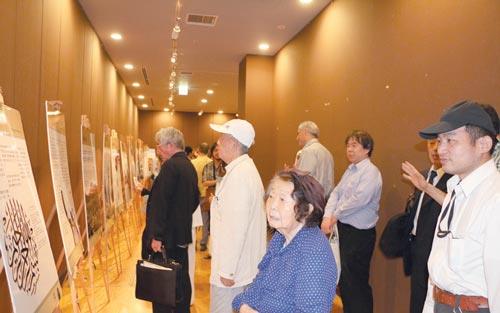Japan Exhibits Message of Islam

“The Japanese public is open to learn new things. The Japanese are interested in learning about Islam,” Professor Katashiro Kohara, the director of the Centre for Monotheistic Studies, said in a speech about the Exhibition cited by the Oman Observer.
“The Exhibition gives the Japanese another chance to learn about the basic principles of Islam and the great contributions of Oman in spreading the message of tolerance,” he added.
Kohara was speaking as the forty-sixth edition of the “Message of Islam from Oman” Exhibition was inaugurated at Doshisha University.
The event is organized and supervised by the Ministry of Awqaf and Religious Affairs in a range of countries around the world.
The exhibition offers the audience a tour into the details of public life in the Sultanate of Oman as well as the role of values and ethics in promoting the concept of co-existence.
This is reflected by an admirable collection of twenty-five paintings focusing on manifestations of coexistence, mutual understanding and harmony among the members of the community.
“The best thing we can do is to spread the messages of peace and goodwill among the entire mankind,” Dr Mohammad bin Said Al Maamari, the Scientific Adviser at the Office of the Minister of Awqaf and Religious Affairs and the supervisor of foreign exhibitions, said.
The role of Oman in spreading the Islam message of tolerance has been praised all through the exhibition.
“I thank the Sultanate of Oman on this good Exhibition that impressed the Japanese,” Professor Samir Noah, a professor at the Centre for Monotheistic Studies, said.
“The most important thing is that the Islamic customs, traditions and morals are fully compatible with those of the Japanese society. This made the Event a great success. In fact, we have never seen a more wonderful night. Thank you!”
The Omanis embraced Islam freely after Prophet Muhammad (Peace and Blessings of Allah be upon him) sent a letter to Abdul and Jeffer sons of Jalandi inviting them to Islam.
They accepted Islam voluntarily and delegations were exchanged so that the Omani people could learn the religion of Islam.
Pride
Coming to Japan for the first time, the exhibition has been welcomed by Muslim students studying at the Japanese university.
“Islam is embodied in Oman. The Exhibition hold at the Doshisha University made me feel very happy that the influence has spread in the form of Exhibitions around the world, and arrived here in Japan, specifically in the city of Kyoto, where I study,” Azza al Ismail, a female Omani student who complements her Graduate Studies at Kyoto University of Japan, told the Observer.
“The smell of my homeland, tolerance and coexistence… I hope all that extend everywhere,” said Al Ismail.
Professor Junia Shinohi, a professor of Theology at the University of Doshisha, shared similar gratitude.
“This gathering is very important as it enables the Japanese understand Islam in general and Oman, in particular.”
Islam began in Japan in the 1920s through the immigration of a few hundreds of Turkish Muslims from Russia following the Russian revolution.
In 1930, the number of Muslims in Japan reached about 1000 of different origins.
Another wave of migrants who boosted the Muslim population reached its peak in the 1980s, along with migrant workers from Iran, Pakistan and Bangladesh.
Japan today is home to a thriving Muslim community of about 120,000, among nearly 127 million in the world's tenth most populated country.
Source: On Islam



